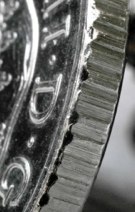Thinking Big @ 09-Oct-13

What I have learnt about macro: (If impatient, skip to last paragraphs!)
I have been taking macro for a very long time - I started in film in fact, with manual focus lenses, which becomes more relevant later in this blog. It has been an interesting journey, with pretty varied results.
On film, macro was hard and frustrating at times, as I had to wait to get the film back to find my framing of the picture was a bit off. By then, of course, the flower had died/the still life was dismantled.... etc.
Time went on, and I got a digital camera (Canon at that time) with a macro lens. Very nice. I could see the effect of what I had taken straight away, had a remote release (so moving the camera by pressing the button didn't cause camera shake) and a nice sturdy tripod. No live view, though (no picture of what I was taking as I was taking it, on the back).
A couple more years on and I was shooting Nikon (don't ask!) with a different macro lens. I was never really happy with what I got. The whole thing seemed fiddly and nothing was ever reliably sharp enough. I got some nice shots (with a rack and bellows focusing system, and with a set of close focus filters, both from SRB Griturn for less than £35 each - I love srb for filters and accessories!) I even got really lovely shots with a 5 year old compact (compacts are wonderful for macro because of the depth of field). But I got far too many duds with my nice new Nikon slr, and I just didn't understand.
But now I do!
Now I have a new, heavier, Nikon camera with very effective live view. I bought a flower, got out my tripod, went to put my camera on and found - that my tripod was not up to the job. And then I realised that my tripod had been the weakest link for some time. The head was wobbly, the quick release plate was wobbly - the whole thing was not up to the job. So I borrowed my husband Martin's tripod with its lovely, heavy duty, tripod head. Now (because I was shooting Nikon and old lenses work on new bodies) I could go back to my original 55mm micro Nikkor lens (under £100 on eBay at the mo), and, with my cable release (though using 2 seconds delay would work just as well) and live view to confirm focusing, I was getting shots so detailed I wanted to cry. So that is the secret (according to me), A sturdy tripod and careful focusing.
Last paragraphs!
You can use a compact in macro mode, and may not even need a tripod for some really good shots. Though a tripod (which can be very small and cheap for a light camera) may help and is essential indoors.
Or, you can use an slr. For this, unless you have a really steady hand and are outdoors, you will need a sturdy enough tripod for the weight of your kit, with a head that moves in all directions - a ball head, for example. You will also need either a remote trigger, or to use delay when shooting (all slrs I have seen will do this, and, for that matter, most compacts will). Live view/ a focusing screen are definite pluses.
Use the lowest ISO you have and a tripod unless you are hand holding out of doors, and switch off image stabilisation on a tripod. Don't automatically reject cheaper lenses and adaptors - my micro nikkor, apparently, has a massive reputation, and close focusing adaptors of one sort and another can give good, though probably not perfect, results, and are a lot of fun to use. I have used screw in SRB macro adaptors at work on an entry level Canon slr and kit lens with great results. SRB also sell adaptors that allow you to use a range of lenses in manual mode on a range of cameras.
Flash is difficult with macro. Macro ring flashes are good but expensive, but a table lamp can supply directional light - though the white balance will be different from daylight. Auto white balance may well deal with this.
Finally, you just don't get the same depth of field with magnifying lenses close up as you seem to get on landscapes. You need to decide what to focus on - what needs to be sharp and what will look okay to the viewer out of focus. Because some things will always be at least a bit out of focus if you are shooting macro on an slr. f11-16 is generally the best aperture for quality, but you can use a smaller aperture (eg f22) for more depth of field if you are prepared to lose a little quality. Focus drops off gradually both in front of and behind the focusing point, so you could focus a little way in to the subject and get 'acceptable' focus both sides of the focus point. See what works for you. Then there is focus stacking - a whole other ball game. Ask Bob!
An interesting website (one of many!): http://www.cambridgeincolour.com/tutorials/macro-lenses.htm
Happy shooting! Sue.